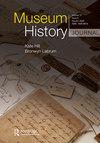Regional identity and national identity. Provincial museums in Prussia at the turn of the twentieth century
IF 0.2
Q3 HISTORY
引用次数: 0
Abstract
In European countries at the turn of the nineteenth and twentieth centuries, there was a trend to create regional museums. In Prussia they were opened in the capitals of twelve Prussian provinces, and they had an important role in shaping the regional identity of the province. In three German regions, the situation was more complicated, as they were inhabited by representatives of another nation: the Province of Posen with a Polish population and Schleswig-Holstein with a Danish population, and Alsace inhabited by the Alsatians, a region situated within the Empire but strongly influenced by Prussia. In these regions, museums operated against the complex historical background and collecting conditions, and their functions and goals were often viewed with indifference or hostility by the local non-German population. In Schleswig-Holstein, the point of contention were prehistoric relics, including the famous Flensburg collection, created by Danes and taken over by Prussians. In Poznań, the German museum ignored the Polish audience, following a policy that aimed at strengthening the local identity of German residents. The museum in Strasbourg tried to exert similar influence, focusing on the historical and artistic ties between Alsace and Germany. However, the Alsatians themselves already sought their own, separate local identity.地域认同和国家认同。二十世纪之交普鲁士的省级博物馆
在十九、二十世纪之交的欧洲国家,有一种建立地区性博物馆的趋势。在普鲁士,它们在12个普鲁士省的首府开设,它们在塑造该省的地区特征方面发挥了重要作用。在德国的三个地区,情况更为复杂,因为这些地区居住着另一个民族的代表:波森省居住着波兰人,石勒苏益格-荷尔斯泰因省居住着丹麦人,阿尔萨斯省居住着阿尔萨斯人,这是一个位于帝国境内但深受普鲁士影响的地区。在这些地区,博物馆在复杂的历史背景和收藏条件下运作,其功能和目标往往被当地的非德裔人口冷漠或敌意地看待。在石勒苏益格-荷尔斯泰因,争论的焦点是史前遗迹,包括著名的弗伦斯堡藏品,由丹麦人创造,由普鲁士人接管。在波兹纳斯,德国博物馆无视波兰观众,遵循旨在加强德国居民当地认同感的政策。斯特拉斯堡的博物馆也试图施加类似的影响,将重点放在阿尔萨斯和德国之间的历史和艺术联系上。然而,阿尔萨斯人自己已经在寻求自己独立的地方身份。
本文章由计算机程序翻译,如有差异,请以英文原文为准。
求助全文
约1分钟内获得全文
求助全文

 求助内容:
求助内容: 应助结果提醒方式:
应助结果提醒方式:


